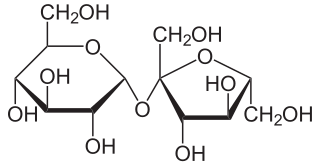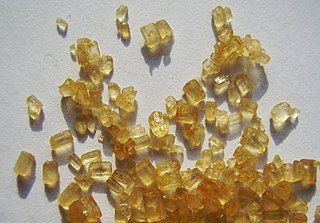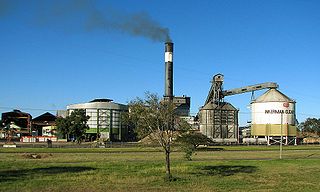
Sugar is the generic name for sweet-tasting, soluble carbohydrates, many of which are used in food. Simple sugars, also called monosaccharides, include glucose, fructose, and galactose. Compound sugars, also called disaccharides or double sugars, are molecules made of two bonded monosaccharides; common examples are sucrose, lactose, and maltose. White sugar is a refined form of sucrose. In the body, compound sugars are hydrolysed into simple sugars.

Fructose, or fruit sugar, is a ketonic simple sugar found in many plants, where it is often bonded to glucose to form the disaccharide sucrose. It is one of the three dietary monosaccharides, along with glucose and galactose, that are absorbed by the gut directly into the blood of the portal vein during digestion. The liver then converts both fructose and galactose into glucose, so that dissolved glucose, known as blood sugar, is the only monosaccharide present in circulating blood.

Sucrose, a disaccharide, is a sugar composed of glucose and fructose subunits. It is produced naturally in plants and is the main constituent of white sugar. It has the molecular formula C
12H
22O
11.

Molasses is a viscous byproduct, principally obtained from the refining of sugarcane or sugar beet juice into sugar. Molasses varies in the amount of sugar, the method of extraction and age of the plant. Sugarcane molasses is usually used to sweeten and flavour foods. Molasses is a major constituent of fine commercial brown sugar.

Corn syrup is a food syrup which is made from the starch of corn/maize and contains varying amounts of sugars: glucose, maltose and higher oligosaccharides, depending on the grade. Corn syrup is used in foods to soften texture, add volume, prevent crystallization of sugar, and enhance flavor. It can be processed into high-fructose corn syrup (HFCS) by using the enzyme D-xylose isomerase to convert a large proportion of its glucose into sweeter fructose.

In cooking, syrup is a condiment that is a thick, viscous liquid consisting primarily of a solution of sugar in water, containing a large amount of dissolved sugars but showing little tendency to deposit crystals. In its concentrated form, its consistency is similar to that of molasses. The viscosity arises from the multiple hydrogen bonds between the dissolved sugar, which has many hydroxyl (OH) groups.

A refinery is a production facility composed of a group of chemical engineering unit processes and unit operations refining certain materials or converting raw material into products of value.

Inverted sugar syrup, also called invert syrup, invert sugar, simple syrup, sugar syrup, sugar water, bar syrup, syrup USP, or sucrose inversion, is a syrup mixture of the monosaccharides glucose and fructose, that is made by hydrolytic saccharification of the disaccharide sucrose. This mixture's optical rotation is opposite to that of the original sugar, which is why it is called an invert sugar.

Brown sugar is a sucrose sugar product with a distinctive brown color due to the presence of molasses. It is by tradition an unrefined or partially refined soft sugar consisting of sugar crystals with some residual molasses content, but is now often produced by the addition of molasses to refined white sugar.

Tate & Lyle PLC is a British-headquartered, global supplier of food and beverage products to food and industrial markets. It was originally a sugar refining business, but from the 1970s, it began to diversify, eventually divesting its sugar business in 2010. It specialises in turning raw materials such as corn and tapioca into ingredients that add taste, texture, and nutrients to food and beverages. It is listed on the London Stock Exchange and is a constituent of the FTSE 250 Index.

A sugar refinery is a refinery which processes raw sugar from cane or sugar extracted from beets into white refined sugar.

High-fructose corn syrup (HFCS), also known as glucose–fructose, isoglucose and glucose–fructose syrup, is a sweetener made from corn starch. As in the production of conventional corn syrup, the starch is broken down into glucose by enzymes. To make HFCS, the corn syrup is further processed by D-xylose isomerase to convert some of its glucose into fructose. HFCS was first marketed in the early 1970s by the Clinton Corn Processing Company, together with the Japanese Agency of Industrial Science and Technology, where the enzyme was discovered in 1965.

Abram Lyle was a Scottish food manufacturer and politician, who is noted for founding the sugar refiners Abram Lyle & Sons in 1887, which merged with the company of his rival Henry Tate to become Tate & Lyle in 1921.

The history of sugar has five main phases:
- The extraction of sugar cane juice from the sugarcane plant, and the subsequent domestication of the plant in tropical India and Southeast Asia sometime around 4,000 BC.
- The invention of manufacture of cane sugar granules from sugarcane juice in India a little over two thousand years ago, followed by improvements in refining the crystal granules in India in the early centuries AD.
- The spread of cultivation and manufacture of cane sugar to the medieval Islamic world together with some improvements in production methods.
- The spread of cultivation and manufacture of cane sugar to the West Indies and tropical parts of the Americas beginning in the 16th century, followed by more intensive improvements in production in the 17th through 19th centuries in that part of the world.
- The development of beet sugar, high-fructose corn syrup and other sweeteners in the 19th and 20th centuries.

A sugar cane mill is a factory that processes sugar cane to produce raw sugar or plantation white sugar. Some sugar mills are situated next to a back-end refinery, that turns raw sugar into (refined) white sugar.
Critics and competitors of high-fructose corn syrup (HFCS), notably the sugar industry, have for many years used various public relations campaigns to claim the sweetener causes certain health conditions, despite the lack of scientific evidence that HFCS differs nutritionally from sugar. The HFCS industry has tried to respond to these campaigns with their own efforts.

John Joseph Eastick was a British chemist, is noted for being the first chemist at the sugar refinery Abram Lyle and Sons and patenting special methods for making brewers’ saccharum, inverted sugar syrup and golden syrup.
Charles Esau Eastick was a British chemist, noted for formulating golden syrup and patenting special methods for making brewers' saccharum and inverted sugar.


















